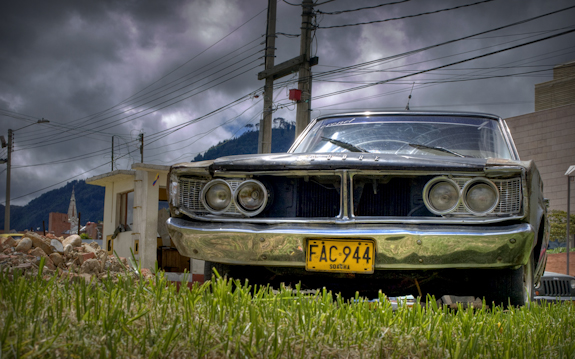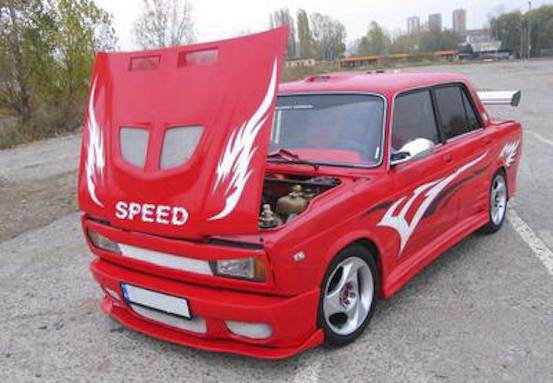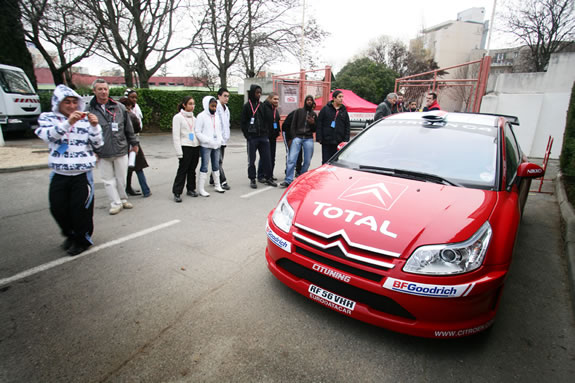" After the second world war, things changed fast in America. Legions of middle-class families abandoned the big cities and built comfortable lives in the suburbs. Few individuals seem prepared to break the chrome-clad, dollar-stamped mould. But one that did was "

Gonzo! Three tales from the road

BUILT FOR SPEED
Breathless to Bogota in a battered old Dodge.
I never realised what a nutter she was. Sure, before we went to Colombia, I should have taken the hint. There was the midnight madness of a cross-London spank in her convertible Twinspark Alfa after the meeting where we discussed the trip, after all. Then, when her interest in all things automotive was made plain to me by the fact that her father raced with Stirling Moss, and her middle name was Hawthorn. All I know is that I shouldn’t have let the photographer drive the most dangerous road in the world. With me in the passenger seat.
Cartagena to Bogota: it had a ring to it. We’d spent the majority of the budget on extended our stay in the National Park up north. A one-way flight back to the Capital was super expensive and the flight path passed dangerously close to the war-wracked hills of Colombia’s central massif. The bus journey up there had been horrific. So, the only thing left was to borrow a motor. The Photographer had a mate down in Bogota who wanted to take delivery of the old clunker , so that was it. Thing is, I’d left my driving licence at home, so therefore, she told me I shouldn’t drive. It’s a laughable contradiction. To be insured comprehensively in Colombia can be likened to being swaddled by a 2 ply continental duvet from Argos at the South Pole, and feeling smug about it.
The two things I remember about this road trip from hell are the treacle thick sensation of fear and the pounding, relentless Salsa that emitted from the speakers of the old wreck. Colombians know nothing about traffic engineering. Road laws are non-existent, and the cops are of course more dangerous than the milita that control the countryside. The two lane highways were a testament therefore to the exuberance of the Colombia temperament and the anarchy that the cocaine economy had bestowed upon its people.
The Photographer was a certified nutcase behind the wheel, though I have to admit, she was rather skilled if ragged in her style. At first I was all for it, the dick and run and jerk and madness of it seemed to fit the surroundings. She’d intersperse her manic jigging to the local rhythms with anecdotes automotive and generally debauched. It was only into the twelfth hour of the trip when the tropical night closed in and the paucity of working head lamps in the nation-state of Colombia began to be all too apparent.
It came to a head when The Photographer insisted on picking up a couple of hitch hikers we met at a midnight road side stop. The two narcotourists from the leafier sides of Surrey and Lincolnshire respectively had been on it for three months solid, all the way up from Cuziosco, via a Yage session communing with spirit guides in the Venezuelan bush, and had lately been shored up in the prettier parts of Caribbean Colombia. Sweaty and mind-bruised to a man and reeking of chemicals and unwashed clothes, they insisted on encouraging The Photographer to race every lampless artic and wobbly wheeled dumper truck to every narrow bridge and around every blind corner that long, viscous night.
By the time we arrived in Bogota my nerves were shot, and I wanted, almost craved _ a serious smashup to wake the photographer from her insane dependence on forward trajectory. Passing the suburbs to the north of the city we saw a dead body rotting in a layby. The cadaver of the middle aged man had on his yellow T-shirt a black logo. BUILT FOR SPEED, it read.
by Michael Fordham
Russian Roulette:
A Cab Through Moscow

The New Russia might have chosen a better ambassador than the taxi driver who collected me from the airport in rare, intense sunshine and heat. The trip would take me straight through the heart of this extraordinary place; it was my first visit, and it wasn’t starting well.
His Ford Focus estate was so trashed the bootlid was jammed shut and we had to fold the rear seats down to load the bags into the boot. Inside, he had a knuckleduster taped to the dash, a knife stabbed into the door trim and a hammer under the seat. There was a picture of a soldier taped to the rear view mirror (brother? Boyfriend? Army buddy killed by the Chechens?) and once we were underway he rolled up his sleeves, trouser legs and the body of his shirt to reveal some horrific scarring, which he proceeded to scratch vigorously for the hour and half it took to get to the centre of the town, a journey lengthened by regular pauses to shout at women by the roadside, and a novel driving technique in which he slowed to 20mph when the road was clear, but weaved at insane speeds through traffic like a crackhead on the run in Police Camera Action. It was the single most terrifying taxi ride I will ever have, but bailing on the well-armed Scratchy and getting lost in this alien city of ten million just wasn’t an option.
In those brief periods when my eyes weren’t tight shut with fear I marvelled at Moscow. The Russians might have come late to capitalism but they’ve embraced it with extraordinary enthusiasm. The billboards here are bigger than anywhere else; we drove past one for BMW next to the Kremlin on the Moscow River that covered an acre and a half and featured all four M-cars suspended on their sides as if they’re racing across it.
Russia’s car boom – and subsequent bust – has brought chronic congestion and parking shortages to this city of 10 million. It is so cold in winter (minus 20 is normal, but they often see minus 35) that Muscovites start their cars and leave them running for an hour before they need to drive. There is an underclass of ancient Ladas, vast, square Volgas, more modern but utterly unremarkable Lada hatches and plenty of Chinese models too, including the infamous Chery QQ, a direct rip-off of the Daewoo Matiz. The bulk of the cars competing with our cab were your standard international small hatch or saloon – Toyotas, Hyundais, Fords and Renaults. But there are probably more high-end cars on the streets here than in any other European city I’ve been to, London excepted, though most of the Bentleys there are driven by Russians anyway. Government officials treat themselves to long black S-classes, A8s and 7-series with discreet blue lights on top, and in that one taxi ride I clocked half a dozen Maybachs, three Murcielagos and my first F430 Scuderia.
Moscow’s roads are a wet dream for those militant motorists’-rights nutjobs you hear on British radio phone-ins; fourteen lanes across in places, with no congestion charge, gas at 50p per litre and virtually no cyclists. But if the police see the slightest infringement they’ll stop you and expect a bribe. There’s an unofficial but well-understood price list, pegged at about half the official fine. Russian motorists are well advised not to protest; one drivers’–rights activist wound up in hospital for a month with severe head injuries.
If only they’d stopped Scratchy, I’d have happily paid his fine, and got another cab. He got me there physically intact, but mentally scarred. I didn’t offer a tip.
by Ben Oliver
Loebmania!

“Don’t you mean merde?” grumbled James, the photographer. Busy fiddling with his cameras in the passenger seat, he hadn’t seen the blue Ford Focus with ‘Gendarmarie’ along its side. That other French word meant police but spelt trouble. The enemy was sat at the side of the motorway on a dusty side road, a speed gun aimed squarely at us, poking out of the driver’s window.
“No, you’re right, it is merde.”
We had only left Calais half an hour earlier and had 500 miles to get to Valence. The Monte Carlo Rally was getting underway and we didn’t need any hold-ups on this 8-hour drive.
Five minutes later and the Focus cop car was on our tail but hanging back. Normally, passing a speed trap in France in an English-plated car would automatically warrant trouble, or at least the raping of an English wallet. But on this trip our ride of choice threw the Gendarme into a world of confusion. We were in a modified Citroen C4. The car belonged to Citroen’s UK press office and was such an accurate replica of Sebastien Loeb’s rally car, we had been causing a right stir since we entered France.
“I had no idea Loeb was so popular” James said.
Since hitting France we had been mobbed at one petrol station, chased by cars with phone cameras waving out the windows and were now being followed by a cop car. Ten minutes of tailing and the police over took and sat in front of us for another five minutes.
Just as we approached a turn off towards a péage booth, the blue lights went on and we were signalled to follow. As we stopped the driver called another officer over from a police station by the edge of the péage. A spikey blonde-haired cop bounced towards us, his wide eyes fixated on the car. He was an amateur rally driver – the first of many we were to meet.
While the young wannabe Loeb looked around the car, the driver showed me my speed on the gun. I had been caught doing 142kph; the limit is 130. “Too fast” he said. Oh bugger, here we go… “Can you take picture please?” Huh?! The chubby lead copper handed me his pocket camera and positioned himself next to the C4 where his exuberant sidekick already stood, wearing a cheesy grin. Fine. We snapped away. They got on their knees and studied the exhaust system, not for legalities but as enthusiasts. We were safe. A few hand shakes and we were on our way. We were driving the ultimate get-out-of-jail –card.
After a weekend of driving where no-one else was allowed, fending off middle-aged female rally fans who wanted to marry Loeb, and a swift police escort up the to the start of the Col de Turini stage, we began our 4-hour trip north. Beaune was our overnight stop before our dash to Calais the following morning.
We were making good time back to Calais. About one song on the iPod later and we barrelled past a speed trap: a camera on a tripod in a layby with a cop car sitting a few metres back from it.
“Merde!!” (again). Thinking we were better off maintaining speed to the next rest area, signposted ahead, and hide, we didn’t slow down, assuming it would take them a while to catch up. We hadn’t considered these speed traps mean a chase car sits further up the road and is radioed by the first.
As we spotted the second Gendarmerie waiting up ahead, our hearts sank. But before I could lift off the gas, it happened again. The uniformed driver, already informed by the first car about us, stuck his upper body out of the window and punched his fist in the air in our honour, before clapping with both hands. We had fooled them and they didn’t care how quick we were going. In fact they saluted our pace. Well, we had just won the rally again.
“Holy shit! Thank God for that,” blurted James.
“No,” I said. “Thank Loeb”
“Same thing over here.”
by Rich Beach
CLICK TO ENLARGE








